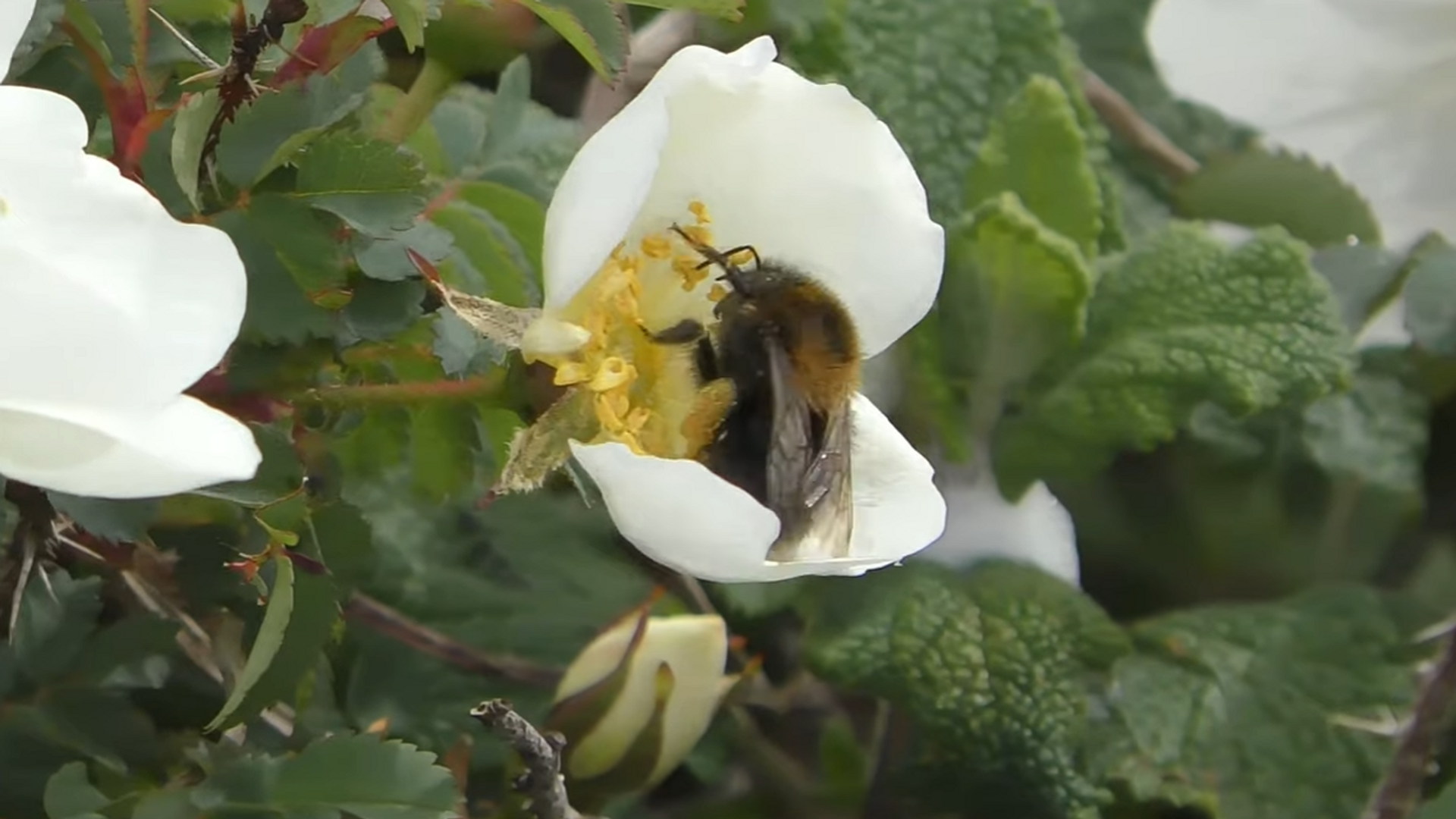https://sputnikglobe.com/20240508/heat-waves-are-further-endangering-bumblebee-populations-study-finds-1118328448.html
Heat Waves Are Further Endangering Bumblebee Populations, Study Finds
Heat Waves Are Further Endangering Bumblebee Populations, Study Finds
Sputnik International
Bumblebee populations are already in decline. But new research illustrates yet another devastating attack on Earth’s beloved pollinators.
2024-05-08T06:47+0000
2024-05-08T06:47+0000
2024-05-08T06:47+0000
beyond politics
society
alps
britain
bees
climate change
weather conditions
extreme weather conditions
heat wave
extreme heat
https://cdn1.img.sputnikglobe.com/img/07e8/05/08/1118328603_0:0:1278:719_1920x0_80_0_0_62c9e155ef20cd625e45d37ac68188e8.png
Bumblebee populations are already in decline. But new research illustrates yet another devastating attack on Earth’s beloved pollinators. What has been described as the “runaway climate crisis” in a recent report, is now threatening the health of nesting bumblebees.According to an international team of researchers who reviewed 180 years worth of scientific literature, heat from the ongoing climate change crisis is a driving force in destroying bumblebee population numbers. Heat has made it difficult for bumblebees to safely construct their homes - where they lay future generations of their brood. Usually, bumblebee colonies have no difficulty in thermoregulating their hive. In hot climates, worker bees will gather and beat their wings to cool their homes down. But the climate crisis has driven temperatures beyond average heat, and bumblebees are now struggling to keep up. Most broods are not able to survive at temperatures 95° Fahrenheit (35° Celsius).The researchers add that no matter which continent a bumblebee brood may reside, their “optimal” temperature for incubating nests is between 82F and 89F (28C and 32C).There have also been reports of bumblebees moving to higher, cooler ground as a way to combat climate change, says Dave Goulson, a professor of biology at the University of Sussex, who was not involved in the research. Other animal populations are experiencing the same climate change-induced migration, including great white sharks which have been found moving up the eastern coastline of the US in an effort to reach cooler waters and higher seal populations.Across the globe there are more than 250 species of bees that are classified as the genus Bombus (bumblebees) with 49 species of bumblebees in the US (2 species are extinct).Goulson, who has studied bumblebees for 30 years, says the recent research is “depressing” and “heartbreaking”. He points out that bumblebee populations have already taken a nosedive due to habitat loss, which in combination with rising temperatures has created a “double whammy."In their paper, the researchers admitted that “the thermal environments in which bumblebee nest (mostly underground, some in cavities, and few on the surface of the ground) are a neglected area in bumblebee ecology.” The researchers have proposed conducting studies using ground-penetrating radar to study ground-nesting species of bumblebees.The study was published in Frontiers in Bee Science.
https://sputnikglobe.com/20240429/us-may-be-facing-its-hottest-summer-ever-1118169104.html
https://sputnikglobe.com/20240506/la-battles-mosquitoes-by-releasing-even-more---1118278717.html
alps
britain
Sputnik International
feedback@sputniknews.com
+74956456601
MIA „Rossiya Segodnya“
2024
News
en_EN
Sputnik International
feedback@sputniknews.com
+74956456601
MIA „Rossiya Segodnya“
Sputnik International
feedback@sputniknews.com
+74956456601
MIA „Rossiya Segodnya“
bees, bumblebees, science, nature, climate change, environmentalism, insects, severe weather conditions, weather conditions, killing bees, killing bumblebees, killing insects, extreme weather conditions, extreme weather, heat wave, extreme heat
bees, bumblebees, science, nature, climate change, environmentalism, insects, severe weather conditions, weather conditions, killing bees, killing bumblebees, killing insects, extreme weather conditions, extreme weather, heat wave, extreme heat
Heat Waves Are Further Endangering Bumblebee Populations, Study Finds
Bumblebees differ from other insects in that they are rotund and furry, making them perfectly suited to colder climates like the Alps and Britain where they thrive.
Bumblebee populations are already in decline. But new research illustrates yet another devastating attack on Earth’s beloved pollinators. What has been described as the “runaway climate crisis” in a recent
report, is now threatening the health of nesting bumblebees.
According to an international team of researchers who reviewed 180 years worth of scientific literature, heat from the ongoing climate change crisis is a driving force in destroying bumblebee population numbers. Heat has made it difficult for bumblebees to safely construct their homes - where they lay future generations of their brood.
“The complex interactions of the mechanisms at the root of the declines are poorly understood,” the
researchers write. “Among the numerous factors, we posit that heat stress in the nests could play a key role in the decline of bumblebee species.”
Usually, bumblebee colonies have no difficulty in thermoregulating their hive. In hot climates, worker bees will gather and beat their wings to cool their homes down. But the climate crisis has driven temperatures beyond average heat, and bumblebees are now struggling to keep up. Most broods are not able to survive at temperatures 95° Fahrenheit (35° Celsius).
The researchers add that no matter which continent a bumblebee brood may reside, their “optimal” temperature for incubating nests is between 82F and 89F (28C and 32C).
“If [bumblebees] can’t keep temperatures below what is probably a lethal limit of about 35C, when the brood may die, that could explain why we are losing so many bumblebees around the world, especially in North America and Europe,” said Peter Kevan, the lead author of the study.
There have also been reports of bumblebees moving to higher, cooler ground as a way to combat climate change, says Dave Goulson, a professor of biology at the University of Sussex, who was not involved in the research. Other animal
populations are experiencing the same climate change-induced migration, including great white sharks which have been found moving up the eastern coastline of the US in an effort to reach cooler waters and higher seal populations.
Across the globe there are more than 250 species of bees that are classified as the genus Bombus (bumblebees) with 49 species of bumblebees in the US (2 species are extinct).
Goulson, who has studied bumblebees for 30 years, says the recent research is “depressing” and “heartbreaking”. He points out that bumblebee populations have already taken a nosedive due to habitat loss, which in combination with rising temperatures has created a “double whammy."
In their paper, the researchers admitted that “the thermal environments in which bumblebee nest (mostly underground, some in cavities, and few on the surface of the ground) are a neglected area in bumblebee ecology.” The researchers have proposed conducting studies using ground-penetrating radar to study ground-nesting species of bumblebees.
“We hope that future scientists may take the ideas we present and apply them to their own research on bumblebee health and conversation,” said Kevan.
The study was published in Frontiers in Bee Science. 



